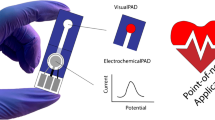Abstract
Bloodstain pattern analysis is occasionally required in practical forensic casework. Misinterpretations may occur in cases in which diluted bloodstains are formed either within the course of the crime or during cleaning attempts after the original crime. The resulting pale or diluted aspect of the bloodstains may also be produced by passive serum separation. To differentiate between diluted and non-diluted stains and the artifacts of pure serum separation, dripping experiments were performed using droplets of multiple sizes and dilutions dripped onto common indoor and fabric surfaces. In addition, pools of blood of different volumes were applied to solid surfaces with different inclinations to determine the conditions and properties of serum separation. This study yielded morphological characteristics that enable differentiation between stains of diluted and non-diluted blood: a prominent ring phenomenon indicates dilution with water. To elucidate the underlying physical mechanism of particle distribution within a blood stain, photomicrographs were taken during the drying process. The so-called contact line pinning effect was identified as the formation mechanism of this ring phenomenon. Serum separation was highly dependent on the applied blood volume, the ambient temperature, the time elapsed since the initial deposition, and the degree of floor inclination.






Similar content being viewed by others
References
Karger B, Rand S, Fracasso T, Pfeiffer H (2008) Bloodstain pattern analysis—casework experience. Forensic Sci Int 181:15–20
Kettner M, Ramsthaler F, Schnabel A (2010) “Bubbles”—a spot diagnosis. J Forensic Sci 55(3):842–844
Ramsthaler F, Schmidt P, Bux R, Potente S, Kaiser C, Kettner M (2012) Drying properties of bloodstains on common indoor surfaces. Int J Legal Med 126(5):739–746
Raymond MA, Smith ER, Liesegang J (1996) The physical properties of blood—forensic considerations. Sci Justice 36:153–160
Rossi C, Holbroock M, James ST, Mabel D (2012) Medical and forensic aspects of blood clot formation in the presence of saliva—a preliminary study. J Bloodstain Pattern Analysis 28:2–5
James SH, Kish PE, Sutton TP (2005) Principles of bloodstain pattern analysis: theory and practice. Taylor and Francis – CRC Press, Boca Raton
Laber TL, Epstein BP (2001) Substrate effects on the clotting time of human blood. J Can Soc Forensic Sci 34(4):209–214
Stuart HJ, Kish PE, Sutton TP (2005) Principles of bloodstain pattern analysis: theory and practice. Taylor & Francis, Boca Raton
Xiaoying S, Chih-Ming H, Wong TS (2010) Minimal size of coffee ring structure. J Phys Chem 114:5269–5274
Parisse F, Allain C (1996) Shape changes of colloidal suspension droplets during drying. J Phys II 6:1111–1119
Deegan RD, Bakajin O, Dupont TF, Huber G, Nagel SR, Witten TA (1997) Capillary flow as the cause of ring stains from dried liquid drops. Nature 389:6653
Deegan RD, Bakajin O, Dupont TF, Huber G, Nagel SR, Witten TA (2000) Contact line deposits in an evaporating drop. Phys Rev E 62:756
Deegan RD (2000) Pattern formation in drying drops. Phys Rev E 61:475
Marin AG, Gelderblom H, Lohse D, Snoeijer JH (2011) Rush-hour in evaporating coffee drops. Phys Fluids 23, 091111, available incl. video: http://arxiv.org/abs/1010.3168
de Castro T, Nickson T, Carr D, Knock C (2013) Interpreting the formation of bloodstains on selected apparel fabrics. Int J Legal Med 127(1):251–258
Karger B, Rand SP, Brinkmann B (1998) Experimental bloodstains on fabric from contact and from droplets. Int J Legal Med 111(1):17–21
Kettner M, Schmidt A, Windgassen M, Schmidt P, Wagner C, Ramsthaler F (2014) Impact height and wall distance in bloodstain pattern analysis—what patterns of round bloodstains can tell us. Int J Legal Med 129(1):133–140
Author information
Authors and Affiliations
Corresponding author
Ethics declarations
Ethic approval was obtained from local ethical committee of the University of Saarland Medical School in Homburg/Saar. Informed consent was obtained from all individual participants included in the study.
Conflict of interest
The authors declare that they have no competing interests.
Electronic supplementary material
Below is the link to the electronic supplementary material.
Fig. S1
a) Circle diagram displaying the negative or very low chemoglobin content of 10 different samples of the separated serum component of the obtained from bloodstains; b–c) boxplots illustrating the hemoglobin content in venous blood samples: b) undiluted venous blood; c) blood diluted in water 1:1; and d) 1:10 (GIF 91 kb)
Rights and permissions
About this article
Cite this article
Ramsthaler, F., Schlote, J., Wagner, C. et al. The ring phenomenon of diluted blood droplets. Int J Legal Med 130, 731–736 (2016). https://doi.org/10.1007/s00414-015-1304-1
Received:
Accepted:
Published:
Issue Date:
DOI: https://doi.org/10.1007/s00414-015-1304-1




